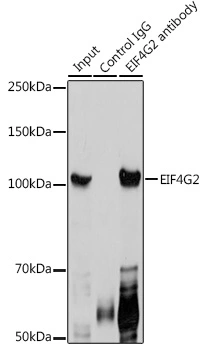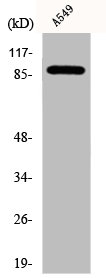DAP5 antibody
GTX101710
ApplicationsImmunoFluorescence, Western Blot, ImmunoCytoChemistry, ImmunoHistoChemistry, ImmunoHistoChemistry Paraffin
Product group Antibodies
TargetEIF4G2
Overview
- SupplierGeneTex
- Product NameDAP5 antibody
- Delivery Days Customer9
- Application Supplier NoteWB: 1:500-1:3000. ICC/IF: 1:100-1:1000. IHC-P: 1:100-1:1000. *Optimal dilutions/concentrations should be determined by the researcher.Not tested in other applications.
- ApplicationsImmunoFluorescence, Western Blot, ImmunoCytoChemistry, ImmunoHistoChemistry, ImmunoHistoChemistry Paraffin
- CertificationResearch Use Only
- ClonalityPolyclonal
- Concentration1 mg/ml
- ConjugateUnconjugated
- Gene ID1982
- Target nameEIF4G2
- Target descriptioneukaryotic translation initiation factor 4 gamma 2
- Target synonymsAAG1, DAP5, NAT1, P97, eukaryotic translation initiation factor 4 gamma 2, DAP-5, aging-associated protein 1, death-associated protein 5, eIF-4-gamma 2, eIF-4G 2, eIF4G 2, eukaryotic translation initiation factor 4G-like 1
- HostRabbit
- IsotypeIgG
- Protein IDP78344
- Protein NameEukaryotic translation initiation factor 4 gamma 2
- Scientific DescriptionTranslation initiation is mediated by specific recognition of the cap structure by eukaryotic translation initiation factor 4F (eIF4F), which is a cap binding protein complex that consists of three subunits: eIF4A, eIF4E and eIF4G. The protein encoded by this gene shares similarity with the C-terminal region of eIF4G that contains the binding sites for eIF4A and eIF3; eIF4G, in addition, contains a binding site for eIF4E at the N-terminus. Unlike eIF4G, which supports cap-dependent and independent translation, this gene product functions as a general repressor of translation by forming translationally inactive complexes. In vitro and in vivo studies indicate that translation of this mRNA initiates exclusively at a non-AUG (GUG) codon. Alternatively spliced transcript variants encoding different isoforms of this gene have been described. [provided by RefSeq]
- Storage Instruction-20°C or -80°C,2°C to 8°C
- UNSPSC12352203



![FACS (Intracellular staining) analysis of CHO (A) and HEK293 (B) cells using GTX11929 DAP5 antibody [39C534.1]. Blue : Primary antibody Orange : isotype control Dilution : 1 microg/1 x 10? cells](https://www.genetex.com/upload/website/prouct_img/normal/GTX11929/GTX11929_53_FACS_w_23060519_286.webp)


